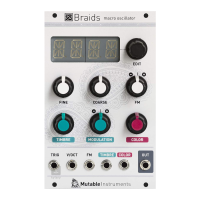
Do you have a question about the Mutable Instruments Braids and is the answer not in the manual?
| Brand | Mutable Instruments |
|---|---|
| Model | Braids |
| Category | Music Equipment |
| Language | English |
Controls module display, selection of synthesis models, and access to settings.
Knobs B and C adjust the primary pitch of the oscillator.
Knob D controls the amount and polarity of FM CV input.
Knob E adjusts the main evolution and motion of the timbre.
Knob F controls the amount and polarity of TIMBRE CV input.
Knob G controls a second dimension of sound, like symmetry or modulation frequency.
Serves three purposes: sound excitation, oscillator reset, or internal AD envelope trigger.
Controls the oscillator frequency with 1V/Oct standard.
Input for frequency modulation, scaled by the FM attenuverter.
Control voltages for the Timbre and Color parameters.
The main audio signal output.
Inspired by Yamaha CS80 sawtooth wave with a fixed-width notch.
Morphs from triangle to sawtooth to square to pulse waveforms.
Blends dephased sawtooth with a PWM square wave.
Synthesizes classic 2-oscillator hardsync patch with square waves.
Uses sine and triangle oscillators sent into a wavefolder.
Generates a smooth waveform sequence from sine to Dirac comb.
Three sawtooth or square oscillators with individually tuned frequencies.
Three sine wave oscillators ring-modulated together.
Simulates a swarm of 7 sawtooth waves with detuning.
Generates a sawtooth waveform into a comb filter (tuned delay line).
Traverses timbres typical of circuit-bent electronic musical toys.
Synthesizes filter responses like low-pass, band-pass, directly in time-domain.
Emulates formant synthesis using ring-modulation/hardsync patch.
Synthesizes vowel sounds, recreating early computer speech synthesis.
Three flavors of 2-operator phase-modulation synthesis.
Uses additive synthesis to recreate the tone of a bell.
Variant of BELL model for metallic drum sounds.
Raw plucked string synthesis.
Bowed string modeling.
Reed or flute instrument models.
Classic implementation of wavetable synthesis.
Two-dimensional implementation of wavetable synthesis.
One-dimensional scanning through wavetables.
A 4-voice variant of WLIN with different harmonic structures.
Filters white noise with a state-variable filter.
Generates white noise processed with two band-pass filters.
Generates random samples at a given rate.
Granular synthesis models using sine waves or decaying pings.
Generates modulated signals used in digital telecommunication.
Selects the bit-depth of the data sent to the DAC.
Selects the refresh rate of the DAC.
Selects the trigger source (external or automatic).
Applies a delay between trigger reception and note strike.
Defines action upon trigger input: SYNC, TIMB, LEVL, or BOTH.
Selects a preset shape for the internal AD envelope.
Allows synthesis model selection via FM CV input.
Chooses the range for the coarse frequency knob.
Switch for octave transposition.
Quantifies the incoming V/Oct signal to semitones or quarter tones.
Applies detuning in lower and higher frequencies.
Recreates VCO imperfections from power supply and noise.
Applies glitches/waveform imperfections to the output signal.
Adjusts the screen brightness.
Procedure to scale input control voltages for accurate operation.
Visual representation of internal ADC readings for inputs.
Allows editing of text strings using the encoder.
Step-by-step guide for updating the module's firmware.
Details Mutable Instruments' warranty terms and conditions.
